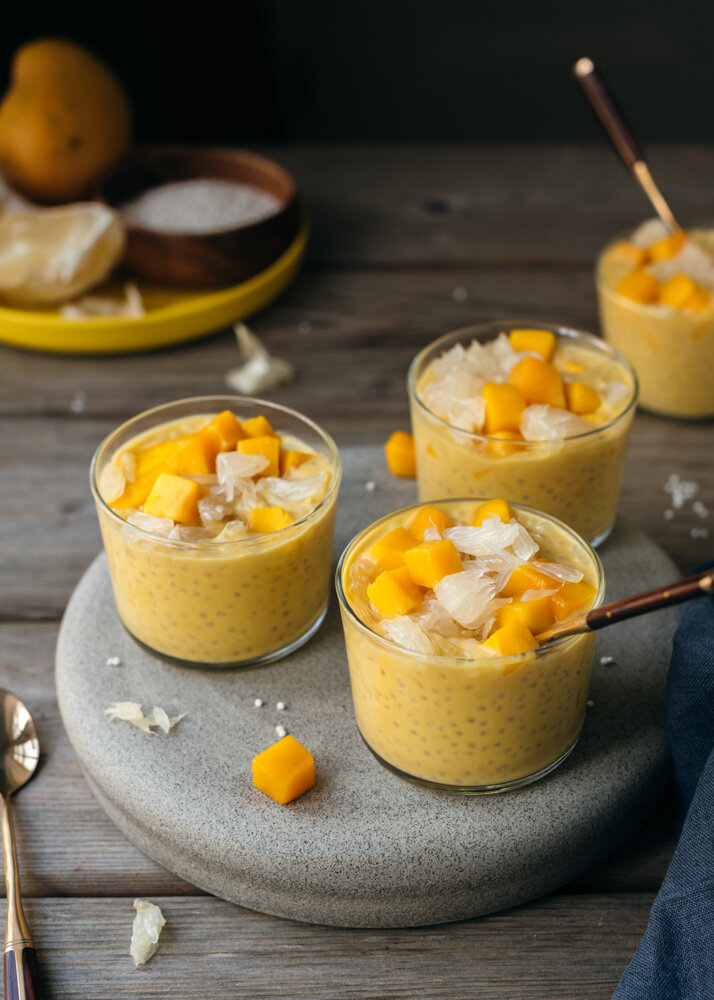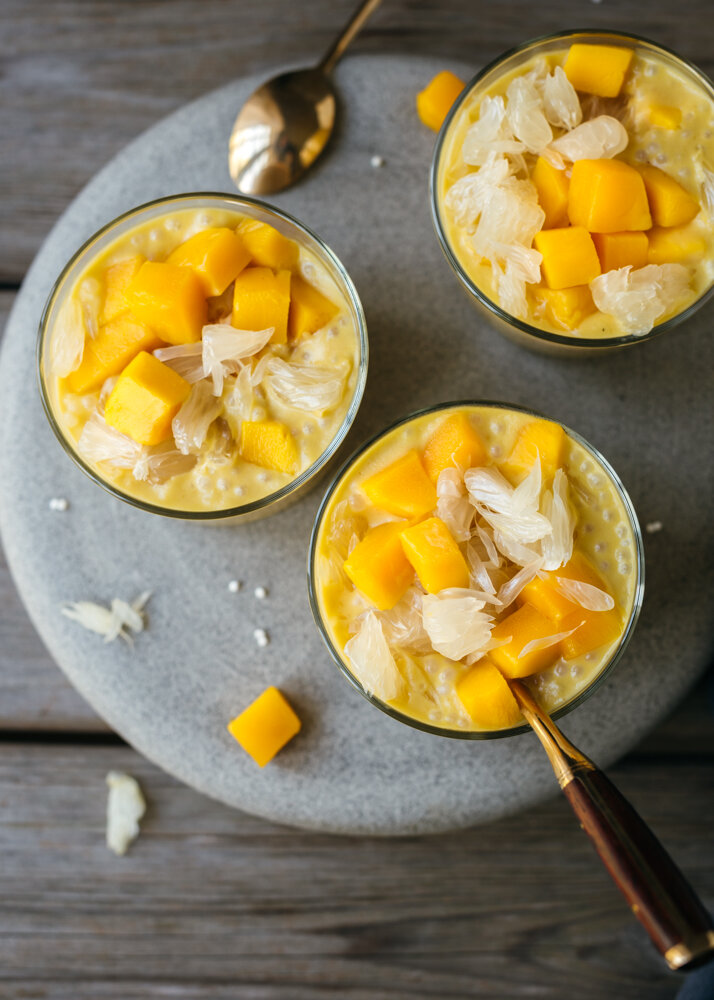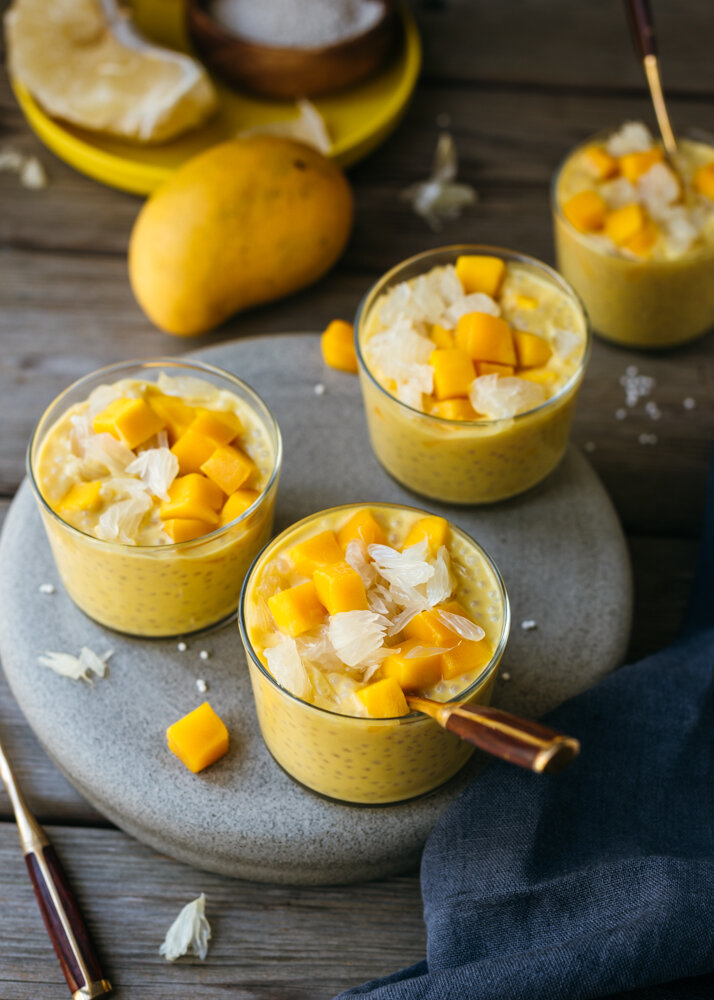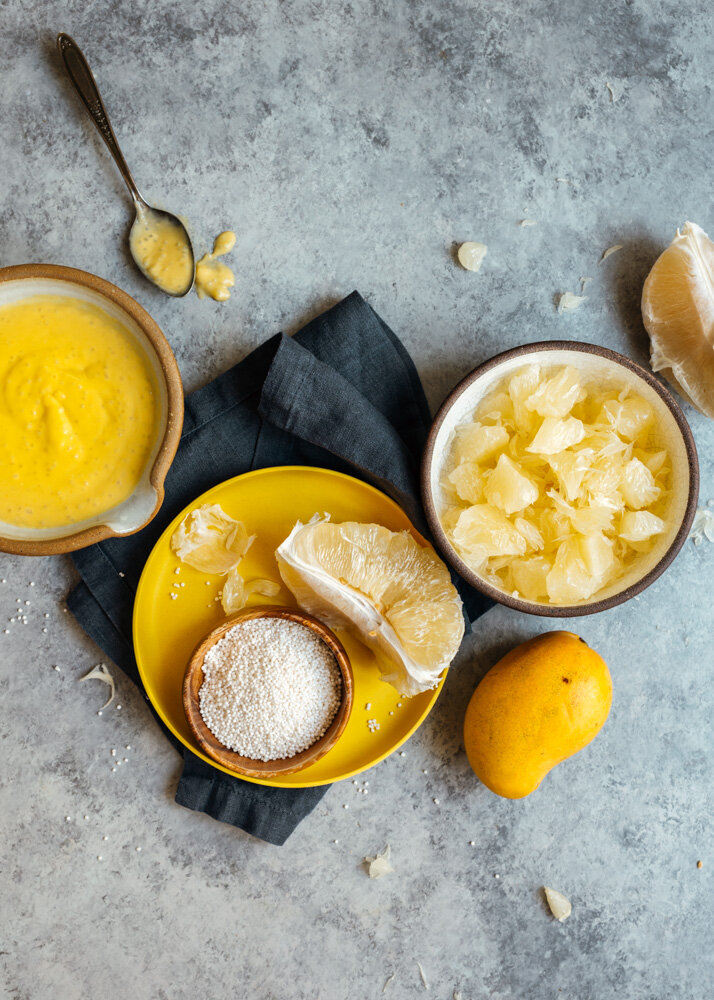Mango Sago Pudding { 芒果西米露 }
I'll concede that as far as food trends go these days, you're much more likely to see a chia pudding appear on your Instagram feed than a tapioca pudding! You might even say the latter is a little old-school. But to me, this MANGO TAPIOCA (SAGO) PUDDING { 芒果西米露 } has a special nostalgia and holds a supreme ranking as far as desserts that delighted me as a child. And as an adult!
In my childhood, there were two kinds of tapioca puddings. One made with milk and eggs, similar to the Western version except it also has a sweetened lotus seed paste inside. It may be offered at your dim sum restaurant, if you're lucky! The other is inspired by south-east Asian cuisines, called ‘sago’ and is made with coconut milk and typically married with mango, pomelo or ube. Both are extraordinarily good. This post is all about MANGO TAPIOCA (SAGO) PUDDING, which is a light and refreshing dessert to enjoy as we approach hotter days.
The recipe is dairy-free and vegan (no eggs or cow’s milk), naturally grain-free since tapioca is made from the cassava root, and refined sugar free if sweetened with pure maple syrup. If you've never had this before, something wonderful happens when you combine coconut milk + tapioca + maple syrup + mango!
I prepare my MANGO TAPIOCA (SAGO) PUDDING differently from most. It’s more of a western method of cooking tapioca pudding. I soak and cook the tapioca pearls directly in the milk mixture, rather than cooking tapioca separately. I find it easier (fewer dirty dishes to wash 😉) and as long as you follow the recipe directions and watch closely to avoid overcooking the tapioca, the result is still chewy, bouncy balls suspended in sublime pudding.
Pomelo looks like a supersized grapefruit, with either yellow or green exterior. Its flesh is a pale champagne or pale pink depending on variety, drier + less bitter than grapefruit. They usually come from Thailand, Vietnam or China. I see them often at mainstream markets now, especially during the Canadian winter time! Asian markets tend to have them all year round. Omit if you can’t find it.
Recipe Head Notes - Mango Sago Pudding:
Tips for cooking tapioca pearls:
How long to cook: There is a small window when the tapioca pearls are perfectly cooked, before they can quickly become mushy and goopy so keep a close eye when cooking them.
What to look for: Use the recipe time as a guideline, making sure to rely mostly on visual queue for doneness. That is, when pearls are mostly translucent with a pin-dot of opaque remaining in the center. They will continue to cook through in the residual heat as the mixture cools. They will not all look equally cooked through, even with constant stirring, so just look for this doneness in the majority of the pearls.
Sweetness level: The base amount of sugar (or maple syrup) as written is ¼ cup but you may add up to another ¼ cup for a full ½ cup of sweetener. I am a ‘half sweet’ kind of person at Starbucks so naturally my palette enjoys moderately sweet things. The sweetness of your mangos is a variable to consider as well when you sweeten your pudding.
Make in advance: Everything can be made, cooled and refrigerated in closed container for 2-3 days, even fully assembled. Great for bringing to parties, picnics or spontaneous needs.
Substituting with chia seeds: Chia seeds which work extremely well Chia seeds is a nutrient-dense superfood. Either black or white chia seeds work equally well although I generally have a personal preference for white chia seeds completely due to their appearance. Either way, it requires no cooking - all that is needed is to soak in the liquid for 30 minutes up to overnight. Soaked chia seeds and cooked tapioca pearls look remarkably alike and similarly neutral in taste. Texture-wise, soaked chia seeds are plump but still retains a slight crunch on the inside when you bite into them, versus cooked tapioca pearls which are chewy and soft all the way through. Use about 2/3 to 3/4 cup of chia seeds, depending on thickness preference. Soak the chia seeds directly in the same amount of almond/coconut milks for 30 minutes up to overnight. No cooking is required for chia seeds. Once soaked, simply sweeten with maple syrup, layer with mango puree and top with fresh mangos.
Mango Sago Pudding {芒果西米露}
{ gluten free, vegan, dairy-free, paleo, refined sugar free option }
Recipe makes 4-6 servings
INGREDIENTS
1/2 C uncooked small tapioca pearls (see note above for substituting with chia seeds)
2 C unsweetened plain oat milk or other plant milk of choice
1 400ml-can full fat coconut milk
1/4 C maple syrup (OR ¼ C organic granulated sugar – add more depending on your taste and sweetness of mangoes (see headnote ‘sweetness level’)
1 tsp pure vanilla extract
2 C small-cubed mangoes, separated (about 3-4 small mangos)
A few segments of pomelo, pulled out of membrane (optional for topping)
METHOD
To a medium pot, add tapioca pearls, oat milk, coconut milk, maple syrup (or sugar) and vanilla extract. Let the mixture soak for about 1 hour in the fridge. I like soaking to give the pearls a head start in absorbing moisture for more evenly cooked tapioca. If you skip soaking time, you will just cook it a little longer.
Give the mixture a stir as some of the tapioca might have sunk to the bottom. Set the pot over a medium heat, bring contents to a boil and quickly turn it down to a lower setting. Simmer gently for about 7-8 minutes, stirring constantly for even cooking. What to look for: Use the recipe time as a guideline, making sure to rely mostly on visual queue for doneness. That is, when pearls are mostly translucent with a pin-dot of opaque remaining in the center. They will continue to cook through in the residual heat as the mixture cools so you don’t want take them too far before removing from heat. They will not necessarily all look equally cooked through, even with constant stirring, but that’s okay just look for this doneness in most of the pearls. Remove from heat, cover and let sit for 5 minutes.
Pour pudding into another vessel and let it cool to room temperature. Put into the fridge to chill rest of the way until cold, about an hour.
Meanwhile, place 1 cup of the diced mangoes in a small blender and puree until smooth (or use an immersion blender). Mix the puree with cooled tapioca mixture. If you like a thinner pudding, stir in a bit more oat milk or coconut milk.
To serve, scoop mango tapioca mixture into serving bowls. Top with the remaining fresh mango cubes and pomelo if using.
Enjoy!
🎥 Watch my IG Reel for Mango Tapioca Pudding
2021 Update: I updated this post with small tweaks to the recipe plus the addition of pomelo as a topping. It is a classic addition to mango sago puddings in Hong Kong. It used to be difficult to source here in Toronto. But four years after this recipe was originally posted, I’ve noticed pomelos being sold even at mainstream grocery chains. See headnote for more information about it.













Hi, I’m Sonia
I share recipes inspired by my food cravings and what I make for my family. My role as a working mom of two girls, my life in Toronto Canada and my background as a Chinese immigrant from Hong Kong all inform the things I love, crave and create. This means an emphasis on wholesome recipes that are approachable for busy weeknights and fun recipes to make on weekends and for friends!
homemade food to nourish and indulge …
More about Sonia >